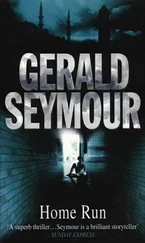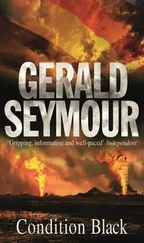Gerald Seymour - A Deniable Death
Здесь есть возможность читать онлайн «Gerald Seymour - A Deniable Death» весь текст электронной книги совершенно бесплатно (целиком полную версию без сокращений). В некоторых случаях можно слушать аудио, скачать через торрент в формате fb2 и присутствует краткое содержание. Жанр: Триллер, на английском языке. Описание произведения, (предисловие) а так же отзывы посетителей доступны на портале библиотеки ЛибКат.
- Название:A Deniable Death
- Автор:
- Жанр:
- Год:неизвестен
- ISBN:нет данных
- Рейтинг книги:3 / 5. Голосов: 1
-
Избранное:Добавить в избранное
- Отзывы:
-
Ваша оценка:
- 60
- 1
- 2
- 3
- 4
- 5
A Deniable Death: краткое содержание, описание и аннотация
Предлагаем к чтению аннотацию, описание, краткое содержание или предисловие (зависит от того, что написал сам автор книги «A Deniable Death»). Если вы не нашли необходимую информацию о книге — напишите в комментариях, мы постараемся отыскать её.
A Deniable Death — читать онлайн бесплатно полную книгу (весь текст) целиком
Ниже представлен текст книги, разбитый по страницам. Система сохранения места последней прочитанной страницы, позволяет с удобством читать онлайн бесплатно книгу «A Deniable Death», без необходимости каждый раз заново искать на чём Вы остановились. Поставьте закладку, и сможете в любой момент перейти на страницу, на которой закончили чтение.
Интервал:
Закладка:
Had he done so he might have realised that a fine film had scattered from his face. Some minuscule droplets had wafted down on to the bench and a few had come to rest on the circuit he was putting together.
He had gone on with his work methodically and carefully. He had built the explosive formed projectile. He had a production line in a small factory area behind his workshop and the shaped copper charge was manufactured there to high-precision standards by experienced technicians. By his late-morning break, he had completed the electronics of a killing kit capable of defeating the electronic counter-measures of his enemy, and had begun on another, using the same procedures and techniques. They could almost have been described as a signature. The device onto which he had sneezed was now sealed, boxed and ready for transportation.
He did not know that the device had failed to detonate. A ‘trigger man’, as the Great Satan’s troops described the bomb layer and the peasant charged with firing the device, had panicked when an attack helicopter had flown low over the sand scrape in which he had hidden himself, some three hundred yards back from Highway 6, the convoy route. He had broken cover and run. Later, to gain the reward of ten American dollars, he had fabricated a story of an advancing foot patrol, the need to destroy the firing software, its burial and his flight. The Engineer did not know that the sight of the man emerging from his hiding place and sprinting towards nowhere had alerted the Apache crew: a follow-up had been mounted and the abandoned device retrieved. That had been four weeks and two days after the Engineer had sneezed at his workbench and given forensic scientists something akin to gold dust: a sample for DNA analysis.
At a laboratory in the west of England, a woman in a white suit with a face mask over her mouth and her hair in a shower-cap, would say: ‘Christmas has come early. It has to be the man who put it together.’ There had been a meeting of ammunition technical officers and explosive ordnance disposal experts and the intelligence had been fed to them. One, who had been to the Palace for a gallantry decoration and was said to have exhausted more lives than any streetwise tom-cat, had said, allowing himself a gallows-humour grin: ‘We chance our bollocks when we’re out in the donkey shit trying to defuse these things in the hope that we can get fingerprints, anything, a speck of blood, because the trigger rag-head cut himself on a thorn – and that’s just to identify a foot-soldier. Here we have the DNA of the top man in the chain. We’ve got it on a plate. That’s a hell of a start.’ The chair of a committee of intelligence officers and agent handlers, gaunt from the weight of responsibility, had briefed: ‘I’m assured that only a small number of men, experts in micro-engineering, are capable of making these things. As you all know, but it’s worth repeating ad nauseam, four in every five of our own and US casualties are laid at the door of these wretched things.’
The Engineer knew nothing about the basic information his sneeze had provided. He had gone on working through a full day until a car had taken him home. He had eaten with his wife and he had told his children, Jahandar and Abbas, the ancient Persian fairy story of Simorgh, and of God’s three sons, Prince Jamshid, Prince Q-mars and Prince Korshid. He had not known of the chasm he had made in his personal security when he sneezed… Neither did he know that fifty-one days later a slim file would be handed to a journeyman intelligence officer charged with the co-ordination of an intelligence trawl.
She had to stand on tiptoe to fasten the top corners of the map to the wall with lengths of Sellotape.
He didn’t help her, but sat down and swivelled away from the pictures of bomb damage. His shoes were on the corner of the desk and his chair tilted comfortably as he gazed at the map. Because Len Gibbons had never been to Iraq, let alone visited Iran, he had little understanding of the terrain, topography and general culture of the area. There were large yellow patches – desert – and a pair of narrow green strips that represented the cultivated, irrigated areas beside the Tigris and Euphrates rivers as they came to a confluence at al-Qurnah before going south as one. There was blue for what seemed to be great inland lakes with little symbols of marshland printed on them. Across the extreme eastern corner of the water-covered area was the bold mauve line of a frontier, and almost on that line, in what was marked as Iran, there was a bold cross in black ink.
She looked at him, and he nodded, all he would offer in the way of praise but Sarah would take no offence. He was, to her, a good man to work for, and she was on board for what the operation sought to achieve. She had no qualms about its morality. She stood for a moment, hands on hips, legs slightly apart, enough to tighten the skirt across her buttocks – but it would have taken more than that to awaken any interest in him. They shared the scent of pursuit and the excitement. She went to make a cup of tea, leaving him to stare at the map.
She could remember the day when his screen had exploded into life, when a sparse file had started to thicken. No one forgot such rare, febrile days.
It was three hundred and nineteen days after Rashid, the Engineer, had sneezed over his workbench that a man walked into the lobby of the British Consulate in the Gulf Emirates city of Dubai and requested a meeting with a diplomat.
The Engineer had gone to work late because he had spent the morning with a doctor in the town of Ahvaz. His wife had been examined because of the persistent, but still relatively mild, headaches that sapped her concentration at work. The doctor had prescribed aspirin and rest, so Rashid had taken Naghmeh back to their new home, then set off for his bench at the small factory. He did not know that an Iranian had requested asylum from the British authorities and would therefore be challenged to explain his value. He did not know that a spook attached to the staff, operating under consular cover, would say, ‘You claim you are a member of the Iranian Revolutionary Guard Corps – you said your unit was from the al-Quds Brigade – but I have to ask what sort of information you might bring with you that would justify from us your asylum and safety. Facts, my friend, are the currency needed.’
And, of course, Rashid, the Engineer, did not know that a traitor who had been assigned as a guard to an inner perimeter of an Iranian Revolutionary Guard Corps camp on the road south from Ahvaz, was now in flight, and faced – if again in the custody of al-Quds – either stoning to death or strangulation at the end of a rope. Perhaps Rashid, the Engineer, had seen this guard as his Mercedes swept him through the gates of the compound; perhaps the man had swung them open and saluted. Rashid did not know that the man had denounced him because death faced him in his own country: his crime had been to defile a commander’s daughter – the girl had been a willing party but now cried rape.
The man said, ‘I can tell you about the Engineer who made the bombs that killed so many of your soldiers, in Maysan and Basra Provinces, and many Americans. I can tell you who he is and where he is from, and where is the camp that he uses for the building of the bombs.’
And he was left in the bare interview room, with a well-muscled security guard, while the intelligence officer composed the signal to London that would ask whether such information was indeed sufficient currency for a promise of asylum – only a promise, of course… And Rashid, the Engineer, knew nothing of this.
It was fifty-one days ago – two years and six weeks after a sneeze – that the defining moment had been reached. Sarah did not have a photograph of the features of the bomb-maker to fasten to the wall on his right; instead a black outline of a head and shoulders was superimposed on a white background with a name: rashid armajanrashid armajan. The moment, savoured with strong coffee, had provided confirmation that the DNA sample extracted from the abandoned workings of an explosive formed projectile matched that of a target identified by a ‘walk-in’ at diplomatic premises on the Gulf. Meetings had started and Len Gibbons had bustled between them. He had contributed little but had taken brief notes. He had learned the requirement of his seniors and how it would be achieved. Matters had been moved forward at a location he could not picture and was marked in his mind only by a crude cross on a map, but that was immaterial to him. He could reflect, gazing at the featureless face and at the name in her bold handwriting, that the moment had brought him considerable satisfaction. The collection of a used cigarette end, smoked only a third down and tossed aside, had supplied the opportunity for the moment, had involved considerable resources, a budget allocation – all handled by Gibbons – and manpower deployment.
Читать дальшеИнтервал:
Закладка:
Похожие книги на «A Deniable Death»
Представляем Вашему вниманию похожие книги на «A Deniable Death» списком для выбора. Мы отобрали схожую по названию и смыслу литературу в надежде предоставить читателям больше вариантов отыскать новые, интересные, ещё непрочитанные произведения.
Обсуждение, отзывы о книге «A Deniable Death» и просто собственные мнения читателей. Оставьте ваши комментарии, напишите, что Вы думаете о произведении, его смысле или главных героях. Укажите что конкретно понравилось, а что нет, и почему Вы так считаете.












